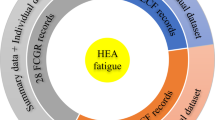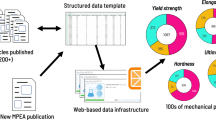Abstract
This work introduces a methodology to assess data quality for the tensile, creep/stress relaxation, and fatigue properties of alloys (as well as metadata associated with manufacture) as a part of a project to develop new materials for extreme environments. The extreme environments in question deal with those found in the power generation sector. Data quality assessment is needed to ensure the reliability of data used in analytics to develop new materials for the power generation sector and to predict the performance of established materials in current use. As data quality metrics have not been standardized for material properties data, quality rating guidelines are developed here for the aspects of data completeness, accuracy, usability, and standardization. The specific design requirements for heat-resistant alloy development were considered in creating each metric. Establishing the quality of a dataset in these areas will enable robust analysis. High-quality data can be set aside to develop predictive models. Lower-quality data need not be discarded but can be used for experimental design. Determining the quality of a materials dataset will also provide additional metadata with the data resource and will promote data reusability. A sample high-quality dataset is presented to indicate the typical data attributes collected from relevant mechanical property testing results, which were considered when generating the data quality metrics. A data template of these attributes was created as a tool for data generators and collectors to promote uniformity and reusability of alloy data. The sparsity of the sample dataset was calculated in order to highlight the areas where data gaps pose a challenge for reliable prediction of creep rupture lifetime.
Similar content being viewed by others
References
Gewin V (2016) Data sharing: an open mind on open data. Nature 529:117–119
Popkin G (2019) Data sharing and how it can benefit your scientific career. Nature 569:445–447. https://doi.org/10.1038/d41586-019-01506-x
Wilkinson MD, Dumontier M, Aalbersberg IJ, Appleton G, Axton M, Baak A, Blomberg N, Boiten J-W, da Silva Santos LB, Bourne PE, Bouwman J, Brookes AJ, Clark T, Crosas M, Dillo I, Dumon O, Edmunds S, Evelo CT, Finkers R, Gonzalez-Beltran A, Gray AJG, Groth P, Goble C, Grethe JS, Heringa J, t’Hoen PAC, Hooft R, Kuhn T, Kok R, Kok J, Lusher SJ, Martone ME, Mons A, Packer AL, Persson B, Rocca-Serra P, Roos M, van Schaik R, Sansone S-A, Schultes E, Sengstag T, Slater T, Strawn G, Swertz MA, Thompson M, van der Lei J, van Mulligen E, Velterop J, Waagmeester A, Wittenburg P, Wolstencroft K, Zhao J, Mons B (2016) The fair guiding principles for scientific data management and stewardship. Scientific Data 3:160018. https://doi.org/10.1038/sdata.2016.18
Gamble M, Goble C (2011) Quality, trust, and utility of scientific data on the web: towards a joint model. In: Proceedings of the 3rd international web science conference, 2011. ACM, p 15
Batini C, Cappiello C, Francalanci C, Maurino A (2009) Methodologies for data quality assessment and improvement. ACM Comput Surv (CSUR) 41:16
ISO/TS 8000 Data Quality (2019) International Organization for Standardization. https://www.iso.org/standard/50798.html. Accessed 12 July 2019
De Guire E, Bartolo L, Brindle R, Devanathan R, Dickey EC, Fessler J, French RH, Fotheringham U, Harmer M, Lara-Curzio E, Lichtner S, Maillet E, Mauro J, Mecklenborg M, Meredig B, Rajan K, Rickman J, Sinnott S, Spahr C, Suh C, Tandia A, Ward L, Weber R (2019) Data-driven glass/ceramic science research: insights from the glass and ceramic and data science/informatics communities. J Am Ceram Soc 102:6385–6406. https://doi.org/10.1111/jace.16677
Sargent P (1992) Data quality in materials information systems. Comput Aided Des 24:477–490
Pipino LL, Lee YW, Wang RY (2002) Data quality assessment. Commun ACM 45:211–218
Wuest T, Mak-Dadanski J, Thoben K-D (2014) Data quality in materials science: a quality management manual approach. In: IFIP International conference on advances in production management systems, 2014. Springer, pp 42–49
Rumble JR (2017) Accessing materials data: challenges and directions in the digital era. Integr Mater Manuf Innov 6:172–186. https://doi.org/10.1007/s40192-017-0095-2
Thirumuruganathan S, Tang N, Ouzzani M, Doan A (2018) Data curation with deep learning [Vision] arXiv preprint. arXiv:1803.01384
Sabbatino M, Baker DV “Vic”, Rose K, Romeo L, Bauer J, Barkhurst A (2018) Starting ‘small’ to go big: building a living database. In: 11th extremely large databases conference, Stanford, CA, April 2018
Hey AJ, Tansley S, Tolle KM (2009) The fourth paradigm: data-intensive scientific discovery, vol 1. Microsoft Research Redmond, WA
Katal A, Wazid M, Goudar R (2013) Big data: issues, challenges, tools and good practices. In: 2013 Sixth international conference on contemporary computing (IC3), 2013. IEEE, pp 404–409
Leskovec J (2011) Social media analytics: tracking, modeling and predicting the flow of information through networks. In: Proceedings of the 20th international conference companion on World wide web, 2011. ACM, pp 277–278
Alamar BC (2013) Sports analytics: a guide for coaches, managers, and other decision makers. Columbia University Press, New York
Erevelles S, Fukawa N, Swayne L (2016) Big data consumer analytics and the transformation of marketing. J Bus Res 69:897–904. https://doi.org/10.1016/j.jbusres.2015.07.001
White A (2012) The Materials genome initiative: one year on. MRS Bull 37:715–716. https://doi.org/10.1557/mrs.2012.194
Jain A, Ong SP, Hautier G, Chen W, Richards WD, Dacek S, Cholia S, Gunter D, Skinner D, Ceder G (2013) Commentary: the materials project: a materials genome approach to accelerating materials innovation. Apl Mater 1:011002
Jose R, Ramakrishna S (2018) Materials 4.0: materials big data enabled materials discovery. Appl Mater Today. https://doi.org/10.1016/j.apmt.2017.12.015
Hill J, Mulholland G, Persson K, Seshadri R, Wolverton C, Meredig B (2016) Materials science with large-scale data and informatics: unlocking new opportunities. MRS Bull 41:399–409. https://doi.org/10.1557/mrs.2016.93
Meredig B, Agrawal A, Kirklin S, Saal JE, Doak J, Thompson A, Zhang K, Choudhary A, Wolverton C (2014) Combinatorial screening for new materials in unconstrained composition space with machine learning. Phys Rev B 89:094104
Ward L, Agrawal A, Choudhary A, Wolverton C (2016) A general-purpose machine learning framework for predicting properties of inorganic materials. npj Comput Mater 2:16028
Agrawal A, Deshpande PD, Cecen A, Basavarsu GP, Choudhary AN, Kalidindi SR (2014) Exploration of data science techniques to predict fatigue strength of steel from composition and processing parameters. Integr Mater Manuf Innov 3:8
Larson F (1952) A time-temperature relationship for rupture and creep stresses. Trans ASME 74:765–775
Mendeley Data (2019) Mendeley Ltd. https://data.mendeley.com/datasets. Accessed 20 July 2019
Verma AK, Hawk JA, Romanov V, Carter JLW (2019) Predictions of long-term creep life for the family of 9–12 wt% Cr martensitic steels. J Alloys Compd 815:152417
Verma AK, Huang WH, Hawk JA, Bruckman LS, French RH, Romanov VN, Carter JLW (2019) Screening of heritage data for improving toughness of creep-resistant martensitic steels. Mater Sci Eng A 763:138–142
Krishnamurthy N, Maddali S, Verma AK, Bruckman LS, Carter JLW, French RH, Romanov VN, Hawk JA (2018) Data analytics for alloy qualification. Office of Fossil Energy, NETL-PUB-21550, 20 March 2018
Romanov VK, Krishnamurthy N, Verma AK, Bruckman LS, French RH, Carter JLW, Hawk JA (2018) Materials data analytics for 9% Cr family steel. Stat Anal Data Min The ASA Data Sci J. https://doi.org/10.1002/sam.11406
Verma AK, Hawk JA, Bruckman LS, French RH, Romanov V, Carter JLW (2019) Mapping multivariate influence of alloying elements on creep behavior for design of new martensitic steels. Metall Mater Trans A 50:3106–3120. https://doi.org/10.1007/s11661-019-05234-9
Krishnamurthy N, Maddali S, Hawk JA, Romanov VN (2019) 9cr steel visualization and predictive modeling. Comput Mater Sci 168:268–279
NIMS (2014) Creep Data Sheet, No. 43a National Institute for Materials Science
NIMS (2013b) Creep Data Sheet, No. 52a National Institute for Materials Science
NIMS (2013a) Creep Data Sheet, No. 51a National Institute for Marine Science
NIMS (2012) Creep Data Sheet, No. 48a National Institute for Materials Science
NIMS (2005) Creep Data Sheet, No. 46a National Institute for Materials Science
NIMS (1998) Creep Data Sheet, No. 10b National Institute for Materials Science
NIMS (1997b) Creep Data Sheet, No. 44 National Institute for Materials Science
NIMS (1997a) Creep Data Sheet, No. 19b National Institute for Materials Science
NIMS (1994) Creep Data Sheet, No. 13b National Institute for Materials Science
NIMS (1982) Fatigue Data Sheet Series, No. 30 National Institute for Materials Science
NIMS (1982) Fatigue Data Sheet Series, No. 29 National Institute for Materials Science
NIMS (2002) Fatigue Data Sheet Series, No. 88 National Institute for Materials Science
NIMS (1983) Fatigue Data Sheet Series, No. 35 National Institute for Materials Science
Rose K, Bauer J, Baker V, Bean A, DiGiulio J, Jones K, Justman D, Miller RM, Romeo L, Sabbatino M, Tong A (2018) Development of an open global oil and gas infrastructure inventory and geodatabase. National Energy Technology Laboratory, Albany, OR. https://doi.org/10.18141/1427573
Acknowledgements
This work was supported by the NETL Crosscutting Research Program, Briggs White, NETL Technology Manager, and Regis Conrad, DOE-FE HQ Program Manager. This work was executed through the eXtremeMAT National Laboratory Field Work Proposal (NETL: FWP-1022433, PNNL: FWP-71133). This project was supported in part by an appointment to the Science Education Programs at National Energy Technology Laboratory (NETL), administered by Oak Ridge Associated Universities through the U.S. Department of Energy Oak Ridge Institute for Science and Education. The authors thank John Oakey for stimulating discussions on data quality metrics based on his work in this area.
Author information
Authors and Affiliations
Corresponding author
Ethics declarations
Conflict of interest
The authors declare that they have no conflict of interest.
Additional information
Disclaimer This work was funded by the Department of Energy, National Energy Technology Laboratory, an agency of the United States Government. Neither the United States Government nor any agency thereof, nor any of their employees, makes any warranty, expressed or implied, or assumes any legal liability or responsibility for the accuracy, completeness, or usefulness of any information, apparatus, product, or process disclosed, or represents that its use would not infringe privately owned rights. Reference herein to any specific commercial product, process, or service by trade name, trademark, manufacturer, or otherwise, does not necessarily constitute or imply its endorsement, recommendation, or favoring by the United States Government or any agency thereof. The views and opinions of authors expressed herein do not necessarily state or reflect those of the United States Government or any agency thereof.
Electronic supplementary material
Below is the link to the electronic supplementary material.
Rights and permissions
About this article
Cite this article
Wenzlick, M., Bauer, J.R., Rose, K. et al. Data Assessment Method to Support the Development of Creep-Resistant Alloys. Integr Mater Manuf Innov 9, 89–102 (2020). https://doi.org/10.1007/s40192-020-00167-3
Received:
Accepted:
Published:
Issue Date:
DOI: https://doi.org/10.1007/s40192-020-00167-3









